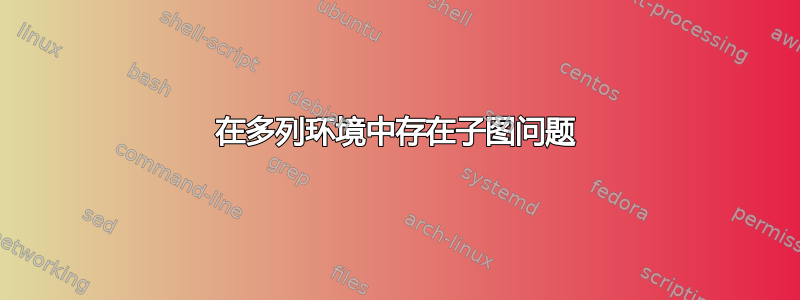
我目前正在处理一个文档,其中一个图形(带有两个子图形)必须放置在这样的两列环境中-
 。
。
我正在使用multicols包来创建 2 列环境。我知道它multocls不允许在其中使用浮点数。为此,我找到了一个建议省略环境的解决方案figure,对于单个数字来说,这对我来说非常有效。
为了放置子图,我尝试了以下包subfigure中的环境:subcaption
\begin{center}
\begin{subfigure}[h]{0.45\linewidth}
\includegraphics[width=\linewidth]{figures/Picture1a.png}
\subcaption{}
\label{fig:one-a}
\end{subfigure}
~
\begin{subfigure}[h]{0.45\linewidth}
\includegraphics[width=\linewidth]{figures/Picture1b.png}
\subcaption{}
\label{fig:one-b}
\end{subfigure}
\captionof{figure}{Border plant (a) and Durba grass (b)}
\label{fig:one}
\end{center}
虽然这显示了子图,但它没有显示子图下的(a)和。(b)
Package caption Error: \setcaptionsubtype outside float上面代码的第 2,4,8,10 行有一个错误。根据我的经验,\subcaption{}应该打印(a)和(b)。
所以这里的问题是,multicols不允许在其中使用浮点数,而subfigure当将其放置在浮点数之外时会引发错误并且不会显示子标题。
关于如何解决这个问题有什么想法吗?
答案1
为了避免您发现的问题,我建议使用twocolumn类似
\documentclass[11pt, twoside, twocolumn]{article}
要以宽模式制作标题页、摘要和表格,请cuted使用\begin{strip} ... \end{strip}
文档的开头应该为
\documentclass[11pt, twoside, twocolumn]{article}
\usepackage{BVetJ}
\usepackage{cuted}% added <<<<<<<<<<<<<<<<<<<<
\title{\color{darkBlue}{Wound healing by border plant and green grass (Durba) in Black Bengal goats: A comparative study}}
\author{Sharmistha Bhattacharjee, Moinul Hasan, Md. Shahadot Hossain, Shahinoor Islam, Md. Mahmudul Alam, Mirza Abul Hashim*}
\affil{\small Department of Surgery and Obstetrics, Bangladesh Agricultural University, Mymensingh-2202, Bangladesh}
\date{\vspace{-10ex}}
\begin{document}
%this creates the top content of the first page
\begin{strip} % added <<<<<<<<<<<<<
\pagestyle{mypagestyle}
\noindent
\begin{minipage}{0.18\textwidth}
\raggedleft
\itshape \bfseries
\includegraphics[scale=0.1]{images/01_BVA.jpg}\\
\hfill
Research Article
\end{minipage}
\hfill
\begin{minipage}{0.50\textwidth}
\centering
\textbf{Bangladesh Veterinary Journal (2021) 55(1-4): 38-45\\
pISSN 0378-8113 \textbullet eISSN 2708-6054}\\
{\footnotesize \url{https://doi.org/10.32856/BVJ-55-2021.04}}
\end{minipage}
\hfill
\begin{minipage}{0.18\textwidth}
\raggedright
\includegraphics[scale=0.2]{images/02_blurrLogo.jpg}
\includegraphics[scale=0.16]{images/03_openAccess.jpg}
\end{minipage}
\begingroup
\let\newpage\relax
\maketitle
\thispagestyle{one}
\endgroup
\hfill\\
\HRule
\begin{abstract}
\addcontentsline{toc}{section}{Abstract}
This investigation was done on 12 Black Bengal goats to find out the comparative effects of border plant and green grass (durba) on histo-morphological changes in the cutaneous wounds at Veterinary Teaching Hospital, Bangladesh Agricultural University. Ten experimental cutaneous wounds for each group (n=04) were made in the goats following standard procedure. In Group A 100\% plant extracts of Border plant (\textit{Aerve sanguinolenta}), in Group B Green grass (durba) (\textit{Cynodon dactylon}) and in Group C control 0.85\% normal saline were applied. Clinical investigation revealed that border plant enhances wound healing within 11 days of treatment, which however takes 14 days for durba grass and 18 days for saline treatment. Clinical features revealed reddening was lower in Group A and B following day 5 of treatment compared to a high level of reddening in the wound areas of control skin. The level of cicatrization and pigmentation of wounds was higher in Group A and B until day 12 of treatment. On day 15 of treatment complete healing was seen in wounds treated with Border plant and durba grasses. Microbiological studies show the microorganisms isolated from the wounds were \textit{Staphylococcus spp}, \textit{E. coli} and \textit{Bacillus spp}. On histopathological studies, the highest degree of inflammation and tissue response was seen in Group A goats trailed by Groups B and C goats. Complete keratinization was only seen over the injured skin of Group A goats following 7 days of treatment compared to incomplete keratinization in Group B and lack of keratinization in Group C. The results indicate that Border plant is an effective topical therapeutic agent followed by green grass (durba) extract for treatment of wounds in Black Bengal goats.
\end{abstract}\vspace*{\baselineskip}
{\small \textbf{Keywords:} Cutaneous wound; Wound healing, Histopathological study}\\
\HRule
\hspace{10mm}
\end{strip} % added <<<<<<<<<<<<<<<<<<<<<<<<<<<<<<<<<<
...
移除所有 \begin{multicols}{2}以及\end{multicols}文档的其余部分。
使用此文件figure1.tex(两个数字并排在一列中)
%% File figure1.tex
\noindent\begin{minipage}{\columnwidth}
\centering
\includegraphics [width = 0.45\columnwidth, height =0.45\columnwidth]{figures/Picture1a.png}
\hfill
\includegraphics [width = 0.45\columnwidth, height =0.45\columnwidth]{figures/Picture1b.png}\\
(a)\hspace{ 0.5\columnwidth}(b)
\captionof{figure}{Border plant (a) and Durba grass (b)}
\label{fig:one}
\end{minipage}
使用此文件table1.tex(两列宽的表格)
%%File table 1.tex
\newcolumntype{P}[1]{>{\centering\arraybackslash}p{#1}}
\begin{strip}
\centering
\captionof{table}{Range of granulation time and complete healing time in different treatment groups of goats}
\label{tab:one}
\renewcommand{\arraystretch}{1.10}
\begin{tabular}{|c|c|P{5cm}|P{4cm}|}
\hline
\textbf{Groups} & \textbf{Treatment used} & \textbf{Range of granulation time (days)} & \textbf{Complete healing time (days)} \\ \hline
Group-A & Border Plant extract & 3-7 & $11\pm0.39$ \\ \hline
Group-B & Durba extract & 3-9 & $14\pm0.29$ \\ \hline
Group-C & Normal saline (0.85\%) & 5-11 & $18\pm0.42$ \\ \hline
\end{tabular}
\end{strip}
输出
第一页
人物
桌子






